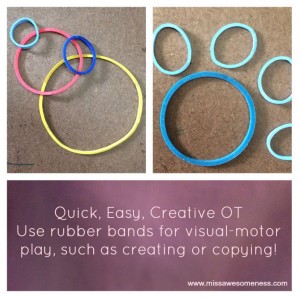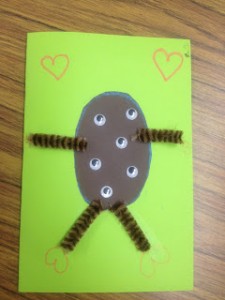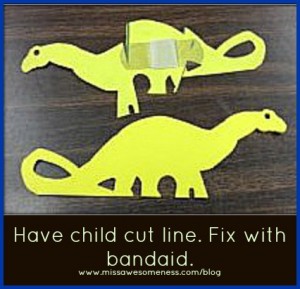activity
OT Lifehack: No more hook marks on your softer clothes
I dislike how softer fabrics get pinched marks in their clothes if left on a hook. I drape my sweaters over instead, but it takes up a lot of space. I realized that my little pediatric “tennis ball head” for kids, with the slit in it for a mouth, could help me out! Check out the picture…
Now, I don’t know if lint will be an issue yet, but you could always buy this vinyl version (Munchy Ball), pre-made, from TherapyFunZone to avoid that issue.
Quick, easy, creative activity: Visual-motor rubber band play
Quick, Easy, Creative OT.
Use rubber bands to work on visual-motor skills! This can be fun and imaginative and a great idea when your options are limited. You can have the child “create” something such as the dog paw seen above on the right, or you can have the child “copy” something! You can focus on figure-ground, spatial orientation, creativity, spatial language (is the blue band under or on top of the red band?), etc! Try to keep this activity play-based. Maybe the bands are actually “bubbles” or you’re giving the dog paw a high-five by placing another dog paw directly on top, whatever. The task can be the same, but the language/drama surrounding it can turn it into play!
The Love Potato: A Unique Valentine's Day Craft Activity
The “love potato” is an awesomely “delightfully awkward” Valentine’s Day Craft that kids and parents alike think is hysterical and definitely unique. The front of the card is a potato with googley eyes all over it, and inside it says “Dear X, I have eyes only for you. Be My Valentine? Love, Kid”.
The “Love Potato” Valentine’s Day Craft Activity
Supplies: construction paper, googley eyeballs, writing/drawing utensils, scissors, glue, pipe cleaners or other item for arms/legs, imagination
Directions:
Choose color of card paper. Fold the paper in half to make the card.
Open card to do message first. Copy or compose the message, making sure to include “I have eyes only for you.” within it.
Draw a potato on a separate piece of brown construction paper. Cut out potato. Glue potato to front of card, in the middle. Add adhesive googley eyeballs to it (dollar store).
Carefully cut pipe cleaners [best by adult] for arms and legs, or use construction paper, crayons, anything else to add in arms/legs. Glue arms and legs of whatever material onto the potato.
Give to cherished person. Smile.
TO GRADE ACTIVITY (change difficulty level) depending on child’s strengths/weaknesses:
Sequencing:
Harder: Show finished product, have child determine sequence of steps (folding/cutting/gluing etc)
Easier: Have a finished product to show, but then do the task step by step with the child, so that task is broken down and child is given sequence.
Following Directions:
Harder: Have no supplies out besides finished product, have kids gather necessary supplies, ideally ones out of sight that require some instruction to find. Provide child minimal instruction and give more than 2 (ideally 3-4) instructions at a time.
Easier: Provide all or most supplies or have easily accessible. Give no more than 1-2 step directions at a time.
Folding:
Harder: Have child perform folding task independently
Easier: Demonstrate how to match corners, and/or perform for child.
Writing:
Harder: Have child make own lines with ruler, and compose without verbal or visual cues. Or have child copy information off board.
Easier: Have written model of desired writing, at “near-point” meaning right in front of the child, for child to copy.
Cutting:
Harder: Thinner potato lines to cut out, or have child cut out arms and legs as well.
Easier: Thicker potato lines, higher-contrast.
Gluing:
Harder: Liquid glue (hard to regulate pressure/squeeze hard enough).
Easier: Ideally a colored glue stick. Ensure child is adding to glue to back of potato, not to card front.
Eyeballs (educate that potatoes have “eyes”)
Harder: Have child pull off own eyeballs, especially smaller ones. If you don’t have the adhesive kinds, putting glue on the eyeballs is hard/good practice. If adhesive, taking the tiny paper off back can be challenging.
Easier: Provide eyeballs off chart, or use larger eyeballs.
Imagination:
Be silly! Kids think this is so funny.
SKILLS worked on with Love Potato activity:
- Cutting
- Gluing
- Folding
- Following directions
- Composing and/or copying writing
- Fine motor manipulation (googley eyeballs plus typical manipulation)
- Imagination/creativity/flexibility
- Cognition/Problem-solving including sequencing and following directions
Cutting/fine motor manipulation/imagination: OT Activity
ACTIVITY
1. Take dinosaur post-it or other random animal paper. Child cuts across animal.
2. Child is veterinarian and fixes animal. (Skim over the fact we were directly responsible for its hurt, cough).
3. Give child a band-aid.
4. Child puts animal pieces together in right orientation, secures band-aid.
See below about grading the activity, skills worked on, and extra notes, while I figure out how to add in a “read more” link 🙂
TO GRADE ACTIVITY (change difficulty level) depending on child’s strengths/weaknesses:
Cutting:
Harder: Multiple lines, thinner lines, curvy or wiggled lines, lower contrast lines, more directions, having child make own lines first and cut out own.
Easier: One thick line, high contrast, fewer directions, no line at all, thicker paper (like a manila folder, construction paper, index card), modified scissors
Band-aid:
Harder:Child gets out band-aid and performs rest of task independently or with minimal assistance, no prompting for sequencing
Easier: Open the band-aid or help the process (start it until manageable by child, such as peeling the bandaid pieces a tiny bit apart and child takes over). Help hold the papers down so child can apply bandaid.
Imagination:
Harder: Do not give the child a sample, fewer prompts, encourage playing pretend
Easier: Role model playing pretend yourself only, give child sample
SKILLS worked on with animal band-aid activity:
- Cutting
- Fine motor manipulation (opening and placing bandaid)
- Visuospatial organization (placing pieces back together)
- Imagination/creativity/flexibility (understanding concept via drama/pretend/silliness)
- Life skill (manipulating band-aid)
- Cognition/Problem-solving (figuring out how to use the band-aid and put it all together)
Notes:
1. Be silly/dramatic. Children with mental rigidity can handle this sort of task as it’s concrete enough to make sense, but the imaginative creative piece is helped by silliness. “Oh nooooo our poor dinosaur!! I hope we can fix him!!!”
2. KIDS LOVE BANDAIDS. I didn’t have any cool ones, but that would help even more. If you have more than one type, let them choose. Even children resistant to cutting/directions may complete this task if they see a band-aid is involved!






